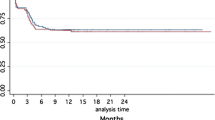Abstract
Background: Laparoscopic inguinal hernia repair frequently is performed with mechanical fixation of a flat polypropylene mesh. Mechanical fixation is associated with pain syndromes, and mesh migration may occur without fixation of flat prostheses. An anatomically contoured mesh (3D Max; Davol, Cranston, RI, USA) using no or minimal fixation would avoid these problems. Methods: A retrospective case study reviewed 212 transabdominal preperitoneal herniaplasties with 11 × 16-cm 3D Max mesh in 146 patients. Fixation with three helical tacks at the most was used early or with very large defects. Results: Fixation was used in 19% of the cases, but only for 1 of the last 98 patients. As reported, 94% of the patients returned to normal activities by 3 weeks, 97% returned to unrestricted sports by 6 weeks, and 92% complete recovery from surgery by 9 weeks. Fixation or bilateral repair did not alter recovery. Four patients had minor pain or numbness. Symptomatic recurrence was 0%. One asymptomatic indirect recurrence was noted on examination, during a mean follow-up period of 23 months, yielding a 0.55% hernia rate and a 0.42% patient-year recurrence risk. Conclusions: An anatomically contoured mesh for transabdominal preperitoneal hernia repair often requires no fixation, with minimal risk of neuropathy and less than a 0.5% patient-year recurrence rate. Recovery is excellent even with bilateral repair or some fixation.







Similar content being viewed by others
References
DC Brooks (1999) ArticleTitleLaparoscopic herniorrhaphy: where are we now? Surg Endosc 13 321–322 Occurrence Handle10.1007/s004649900980 Occurrence Handle1:STN:280:DyaK1M7psVylug%3D%3D Occurrence Handle10094738
E Felix S Scott P Crafton et al. (1998) ArticleTitleCauses of recurrence after laparoscopic hernioplasty. Surg Endosc 12 226–231
R Jago (2001) ArticleTitleStapled and nonstapled laparoscopic transabdominal preperitoneal inguinal hernia repair. Surg Endosc 15 766–776 Occurrence Handle10.1007/s004640000195 Occurrence Handle1:STN:280:DC%2BD3MrksV2quw%3D%3D Occurrence Handle11591999
YS Khajanchee DR Urbach LL Swanstrom PD Hansen (2001) ArticleTitleOutcomes of laparoscopic herniorrhaphy without fixation of mesh to the abdominal wall. Surg Endosc 15 1102–1107
MT Knook WF Weidema LP Stassen CJ van Steensel (1999) ArticleTitleEndoscopic total extraperitoneal repair of primary and recurrent inguinal hernias. Surg Endosc 13 507–511 Occurrence Handle10.1007/s004649901023 Occurrence Handle1:STN:280:DyaK1M3ksVOmug%3D%3D Occurrence Handle10227953
MS Liem Y van der Graaf CJ van Steensel et al. (1997) ArticleTitleComparison of conventional anterior surgery and laparoscopic surgery for inguinal hernia repair. N Engl J Med 336 1541–1547 Occurrence Handle1:STN:280:ByiB1M7jsF0%3D Occurrence Handle9164809
MS Liem Y van der Graaf RC Zwart I Geurts TJ van Vroonhoven (1997) ArticleTitleA randomized comparison of physical performance following laparoscopic and open inguinal hernia repair. The Coala Trial Group. Br J Surg 84 64–76 Occurrence Handle9043455
P Pajotin (1998) ArticleTitleLaparoscopic groin hernia repair using a curved prosthesis without fixation. Le journal de Coelio-Chirurgie 28 64–68
PJ Quilici EM Greaney J Quilici S Anderson (2000) ArticleTitleLaparoscopic inguinal hernia repair: optimal technical variations and results in 1,700 cases. Am Surg 66 848–852 Occurrence Handle1:STN:280:DC%2BD3cvktlGhsw%3D%3D Occurrence Handle10993614
AI Smith CM Royston PC Sedman (1999) ArticleTitleStapled and nonstapled laparoscopic transabdominal preperitoneal (TAPP) inguinal hernia repair: a prospective randomized trial. Surg Endosc 13 804–806 Occurrence Handle10.1007/s004649901104 Occurrence Handle1:STN:280:DyaK1MzlvF2itQ%3D%3D Occurrence Handle10430690
E Stark K Oestreich K Wendl B Rumstadt E Hagmuller (1999) ArticleTitleNerve irritation after laparoscopic hernia repair. Surg Endosc 13 878–881 Occurrence Handle1:STN:280:DyaK1MzotVKmtw%3D%3D Occurrence Handle10449843
Author information
Authors and Affiliations
Corresponding author
Additional information
Financial support for this study was provided by Davol, Inc., Cranst, USA
Rights and permissions
About this article
Cite this article
Bell, R., Price, J. Laparoscopic inguinal hernia repair using an anatomically contoured three-dimensional mesh . Surg Endosc 17, 1784–1788 (2003). https://doi.org/10.1007/s00464-002-8763-4
Received:
Accepted:
Published:
Issue Date:
DOI: https://doi.org/10.1007/s00464-002-8763-4




